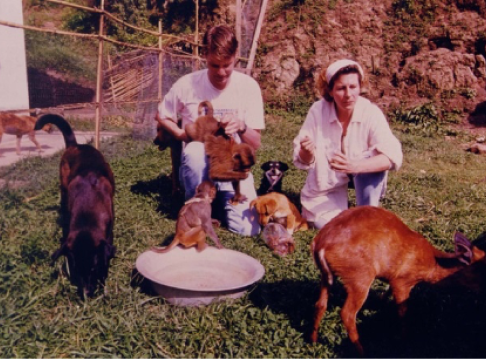The Bhutan Animal Rescue and Care has evolved over the past 17 years from a personal initiative of Marianne Guillet, a French architect and geographer turned veterinarian and Hendrik Visser a Dutch civil engineer and sociologist. Upon their arrival in Bhutan in 1997 they were confronted with a reality of neglect and suffering of sick, injured or starving dogs. Living in the small village of Zhemgang for the first 3 years, they started feeding and treating dogs and bringing them to their home for long term care when necessary. Many cats and dogs with infected wounds, broken bones, sticker sarcoma, or skin diseases were rescued, some of them brought to them by their owners or by compassionate people. They often also brought back home dogs from others parts of the country, which they found crippled in the gutter or dying by the side of the road.

Marianne Guillet, Hendrik Visser, Pilou (first rescued macaque monkey) and other patients, Zhemgang Bhutan, summer 1999.
Each animal was given the proper treatment, vaccinations and de-worming. Sterilisation was the next step before being ready for adoption, or if feasible a return to their original surroundings when e.g. a caring family of food supply were available (restaurants, canteens, market areas). Unfortunately, many patients had to remain with them, being affected by handicaps or debilitating diseases (distemper, epilepsy or chronic illness due to starvation or neglect at an early age). The first baby macaque monkey, Pilou, was rescued from the vegetable market in Thimphu in March 1997. The second baby monkey was brought by a forestry staff who had taken pity on him, being chained to a pole in the south of Bhutan.
With the enduring necessity to rescue and shelter animals in need, their house gradually transformed into a “hospital”. Between June 1997 and December 1999 in Zhemgang, more than a thousand dogs were brought back to health and were sterilised and vaccinated with support from the veterinary services in Thimphu. After moving at the end of 1999 to the capital Thimphu, where the dog
situation was far worse than in the villages and remote areas, the realisation came that they wouldn’t be able to help an ever growing number of animals if they didn’t get organized better. Hendrik and Marianne therefore created a Non-Governmental Organization (NGO) in The Netherlands, the Pilou Animal Rescue and Care, which supported the work in Bhutan and helped in making the animal rescue and care work more effective and efficient.
Most of the work at the shelter was, however, still done and financed directly by Marianne and Hendrik. When a Law was passed in Bhutan, which allowed establishing Civil Society Organizations in Bhutan, they therefore together with friends and supporters established the Bhutan Animal Rescue and Care (BARC). Even if in the coming years the BARC will still run largely on the efforts and support from Marianne and Hendrik, it is anticipated that with this Bhutanese NGO in place the animal rescue work can over time become increasingly sustainable. The latter is especially important since up to now all the animal rescue and care work, a monthly average operational expenditure of about US$ 2,700, is directly financed by Marianne and Hendrik and their total contribution over the past 17 years to treatment and care of animals, including capital investments for the new BARC shelter in 2012/13, is about US$ 450,000.

Marianne Guillet, Hendrik Visser, Pilou (first rescued macaque monkey) and other patients, Zhemgang Bhutan, summer 1999.
Pilou Animal Rescue Care 2025
Design & Developed by Drawah Tech Space